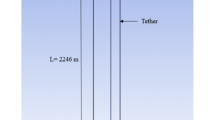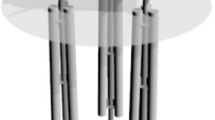Abstract
Oil exploration and production in ultra-deep ice-infested waters demands an innovative structural form to withstand the ice loads. Offshore triceratops is one such new-generation innovative, compliant platforms, which show good adaptability in extreme sea state conditions even under the combined action of wind, waves, and current. As tethers are the crucial components in compliant platforms like a triceratops, it is of paramount importance to study the effect of dynamic ice loads on tether tension variation. The main aim of this study is to carry out the tether tension analysis under the ice force action in different ice sea states. The ice force time history is developed from the continuous crushing ice spectral model, and numerical studies are carried out using Ansys Aqwa by applying the ice force on buoyant legs. The study reveals that the tether tension variation is less than 10% even under extreme ice sea state. The parametric studies are also carried out to assess the effect of ice velocity, ice crushing strength, and ice thickness on tether tension variation. It is found that the maximum stress developed in the wires of tethers is very less compared to the yield stress of the material, ensuring no tether failure. However, a large number of stress cycles may lead to fatigue failure of tethers. Hence, fatigue analysis is also carried out to assess the fatigue damage and service life of tethers. The results show that fatigue damage increases from normal to extreme ice sea state. The results are also compared with open-water load case. Studies carried out under lock-in ice condition shows the increase in the fatigue damage and reduction in the service life of the tethers.
















Similar content being viewed by others
References
White CN, Copple RW, Capanoglu C (2005) Triceratops: an effective platform for developing oil and gas fields in deep and ultra-deepwater. In: The fifteenth international offshore and polar engineering conference, Seoul, Korea, June 19–24, pp 133–139
Chandrasekaran S, Nagavinothini R (2017) Analysis and design of offshore triceratops under ultra-deep waters. World Acad Sci Eng Technol Int J Civ Environ Struct Constr Archit Eng 11(11):1520–1528
Copple RW, Capanoglu CC (1995). A buoyant leg structure for the development of marginal fields in deep water. In: The fifth international offshore and polar engineering conference. International society of offshore and polar engineers
Chandrasekaran S, Sundaravadivelu R, Pannerselvam R, Madhuri S, Varthini DS (2011) Experimental investigations of offshore triceratops under regular waves. In: Proceedings of 30th international conference on ocean, offshore and arctic engineering, OMAE
Chandrasekaran S, Nannaware M (2014) Response analyses of offshore triceratops to seismic activities. Ships Offshore Struct 9(6):633–642
Chandrasekaran S, Nagavinothini R (2018) Dynamic analyses and preliminary design of offshore triceratops in ultra-deep waters. Innov Infrastruct Solut 3(1):16
Chandrasekaran S, Nagavinothini R (2018) Tether analyses of offshore triceratops under the wind, wave, and current. Marine Syst Ocean Technol 13(1):34–42
Ji X, Oterkus E (2016) A dynamic ice-structure interaction model for ice-induced vibrations by using van der Pol equation. Ocean Eng 128:147–152
Yu B, Karr DG, Song H, Srinivas S (2016) A surface ice module for wind turbine dynamic response simulation using FAST. J Offshore Mech Arct Eng 138(5):051501
Shih LY (1991) Analysis of ice-induced vibrations on a flexible structure. Appl Math Model 15(11–12):632–638
Yue Q, Guo F, Kärnä T (2009) Dynamic ice forces of slender vertical structures due to ice crushing. Cold Reg Sci Technol 56(2–3):77–83
Heinonen J, Rissanen S (2017) Coupled crushing analysis of a sea ice-wind turbine interaction–feasibility study of FAST simulation software. Ships Offshore Struct 12(8):1056–1063
Kärnä T, Qu Y, Yue Q, Kuehnlein W (2007) A spectral model for forces due to ice crushing. J Offshore Mech Arct Eng Trans ASME 129:138–145. https://doi.org/10.1115/1.2426997
Det Nor Veritas (2010) Buckling strength of shells, Recommended Practice DNV-RP-C202. Det. Nor. Ver. Class. AS, Veritasveien, 1
Reddy DV, Swamidas ASJ (2013) Essentials of offshore structures: framed and gravity platforms. CRC Press, Cambridge
McCoy TJ, Brown T, Byrne A (2014) Ice Load Project Final Technical Report (No. DDRP0133). DNV GL, Seattle, WA (United States)
Chandrasekaran S (2015) Advanced marine structures. CRC Press, Cambridge
DNV G (2014) Recommended Practice DNVGL-RP-0005: 2014-06 RPC203: fatigue design of offshore steel structures
Blasón S, Correia JAFO, De Jesus AM, Calçada RA, Fernández-Canteli A (2016) A probabilistic analysis of Miner’s law for different loading conditions. Struct Eng Mech 60(1):71–90
Author information
Authors and Affiliations
Corresponding author
Rights and permissions
About this article
Cite this article
Chandrasekaran, S., Nagavinothini, R. Tether analyses of offshore triceratops under ice force due to continuous crushing. Innov. Infrastruct. Solut. 4, 25 (2019). https://doi.org/10.1007/s41062-019-0212-5
Received:
Accepted:
Published:
DOI: https://doi.org/10.1007/s41062-019-0212-5




